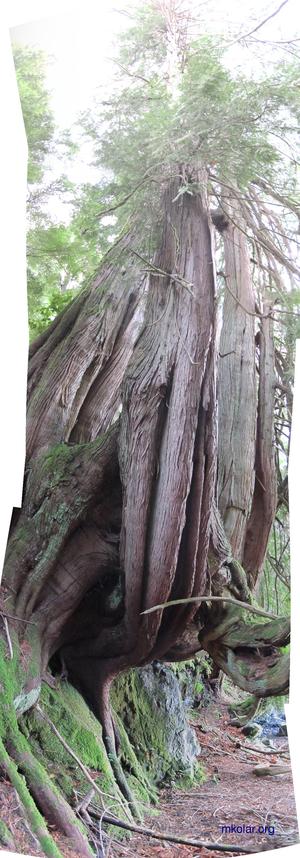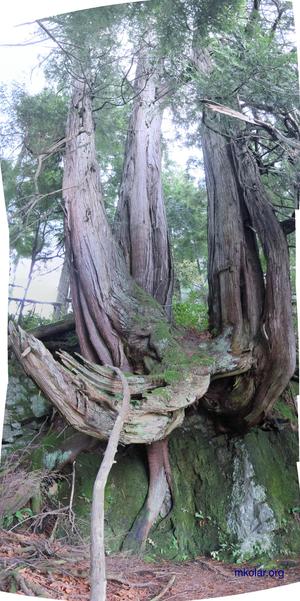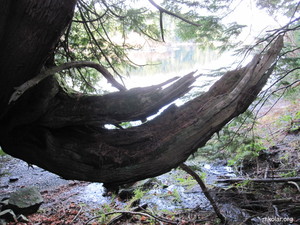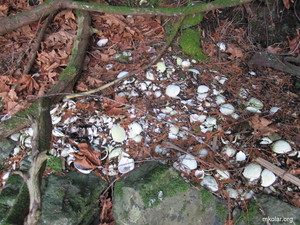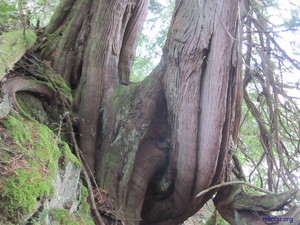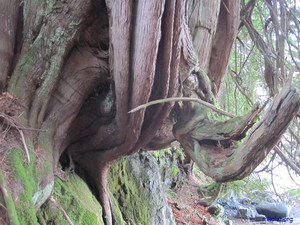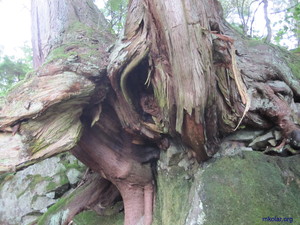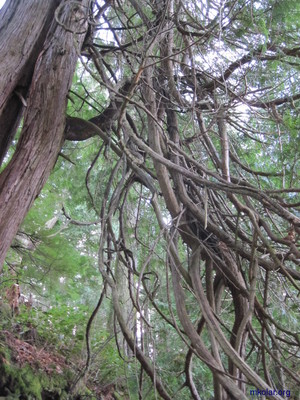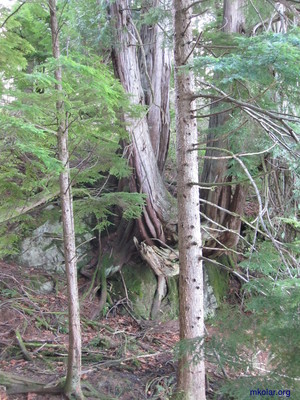A beautiful hidden corner of the Quadra Island
Final edit: January 21, 2014
|
A 23 second video
|
|
Comparison with other old/big trees:
— The oldest living tree discovered on Vancouver Island in 1993 was just over 2000 years old, "born" before Christ, see: World's largest yellow cedars.) — The tallest trees are coast redwoods (sequoia sempervirens) in California, see also here. — The biggest trees are giant sequoias also in coastal California. — To determine which species of trees is living the longest, and which particular tree is the oldest has been less straightforward. While giant sequoias used to be serious contenders also for this title, their oldest known specimen lived only 3266 years. Currently known three longest living individual trees with verified ages are all Great Basin bristlecone pines (Pinus longaeva), two of them in White Mountains, California, the third one was on Wheeler Peak in the neighbouring Nevada. The oldest one of them will reach the age of 5,064 years in 2014. — Actually, the really oldest living trees whose age is however only estimated between 6,000 and 6,800 years may be some of 16 olive trees still producing olives and olive oil in a grove in Lebanon. — One of those three bristlecone pines was unfortunately cut down in 1965 for research purposes under unclear circumstances, when it was actually the longest known living tree at the time. Only a stump is all what now remains of this tree called Prometheus. — Even longer living are Norway spruce, such as the 9,550 years old Old Tjikko in Sweden. However it is only the root system of this tree that has been living continually for 9,550 years, whereas its stem has been repeatedly destroyed by fire, and each new consecutive stem lived no more than 600 years. Therefore Old Tjikko is not considered an individual tree but a clonal system. — The most amazing such clonal system is a colony of male quaking aspen called Pando in Fishlake National Forest, Utah. It occupies an area of 43 ha (106 acres), has over 40 thousand trunks that die individually on average after 130 years, but all are growing from a common root system that is estimated to be between 80,000 and 1 million year old. The whole colony is considered a single living organism, the heaviest on Earth (weighing almost 6000 ton). — When I was searching for information on old trees, I also came across this page on the sacred trees of Crimea (known as Taurica, Taurida or Tauris in antiquity). Among lots of interesting information about various noteworthy trees or groves of Crimea - old or sacred to countless ethnic groups that inhabited Taurida over millenia, and the customs of some of these groups, the following can also be gleaned: as e.g. the mountains of Italy (or more recently all Vancouver Island), also Taurida used to be covered in ancient times by impenetrable forests full of many precious trees. The original inhabitants, Tauri, utilized them in a very sustainable way - harvesting from them only the mastic resin. Later inhabitants had much less reverence for those magnificent trees, and were cutting down and clear-cutting them in ever increasing quantities for firewood, charcoal, shipbuilding, orchard stakes, etc., so that in the end the original beautiful forests were not able to regenerate fast enough and disappeared, completely replaced by low shrubs. Allegedly the worst abuse of the Crimean forests was happening during the period of Crimean Khanate (1441 - 1783). But the first recorded destruction of Crimean trees was that by the early Christian missionaries who were destroying some ancient trees and sacred groves because these were the objects of reverence by pagans. Notably the third Roman Pope Clement I just before the end of the 1st century was there, destroying pagan temples and sacred groves. Than later in the 9th century St. Cyril (born Constantine; the much revered founder of Slavic literacy and the creator of the precursor of the Cyrillic alphabet) personally lead the destruction of a huge ancient oak during his stop in Taurida. Ironically, another unique oak, 1500 years old, the oldest tree of Crimea and possibly of all Europe, in the shade of the branches of which 3,000 people could sit, was cut down in 1922 for firewood. It's not known who's idea it was, but a suspicion was floated that it was cut (in the beginning of Soviet era there) because this oak was revered by the local people (by then long Christian or Muslim - often switching between these two religions when their rulers were changing). Will the mankind ever be able to learn from their past mistakes? By the way, Crimea is also known to be home to huge and old non-native trees - in particular walnut trees brought there by the ancient Greek colonists. One of the largest walnut trees, alive till the second half of the 19th century, was owned for many generations by 16 different families. Individual branches had different owners, who were harvesting every year up to 100,000 nuts from a single branch! |
